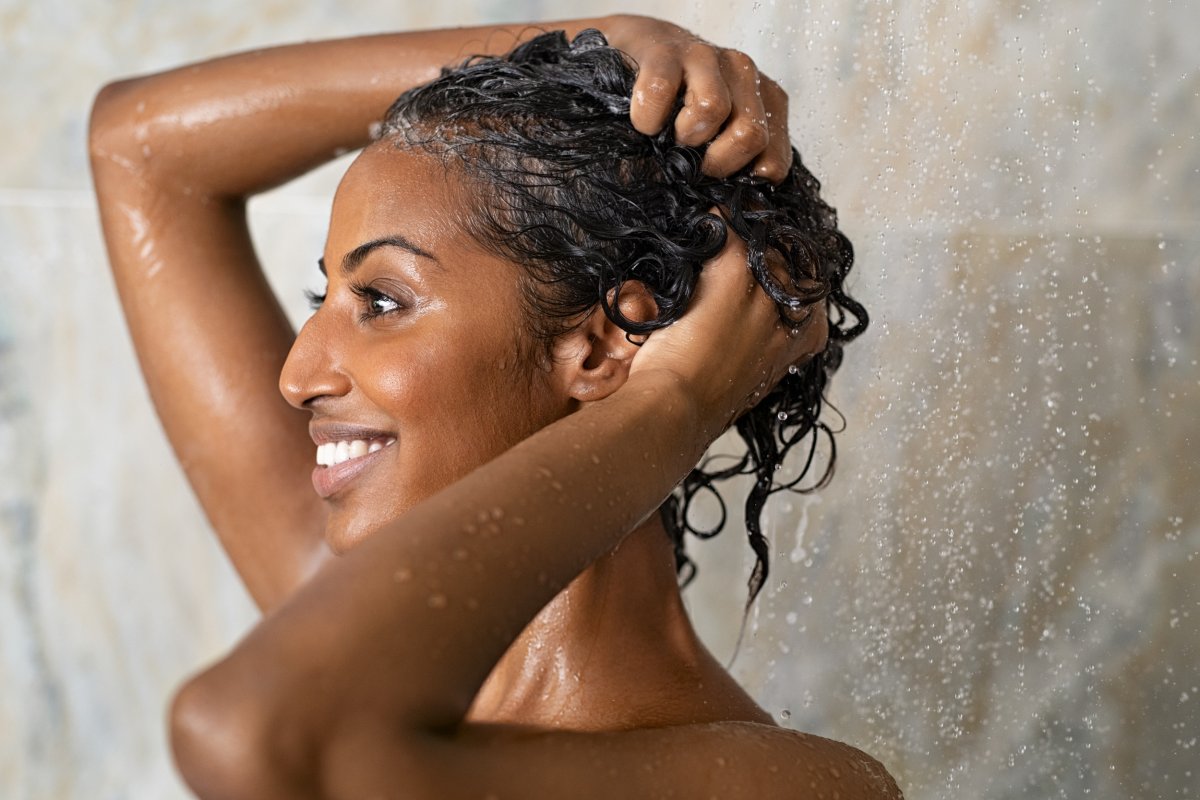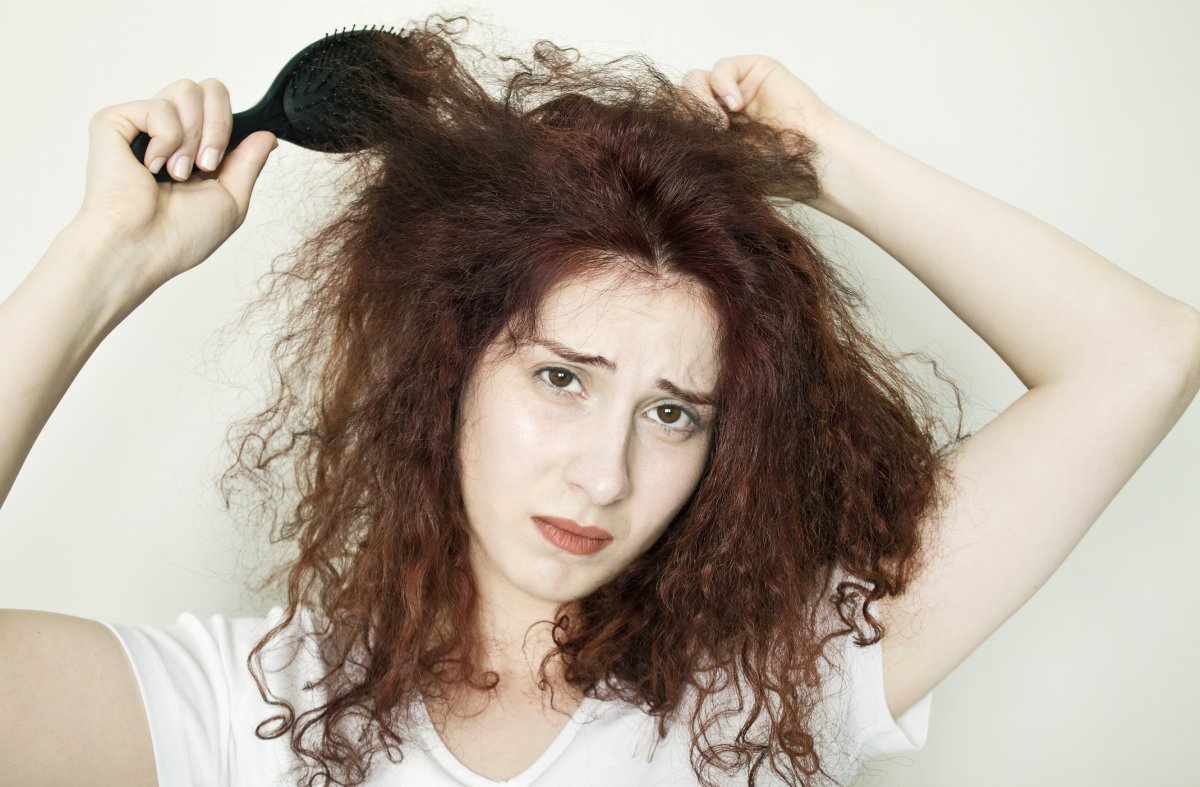How our hair looks can change the way we feel about ourselves. It can be the difference between not just a good hair day or a bad hair day, but a good or bad day overall.
While many people focus on the styling part, experts agree that if you want perfect locks, it all starts with the wash.
One woman on TikTok who cites her interests as “haircare, fashion, and whatever else inspires me” recently shared her experience undergoing the unconventional trend of “showering in reverse.”
In the video, Tessa Peay tried out the backwards hair care method, which involves conditioning before shampooing the roots only.
triocean/Getty Images
“Supposedly this helps protects your mids and ends from the shampoo,” Peay wrote, “keeping your hair more hydrated.”
People will shell out vast amounts of money to keep their hair healthy. The average American woman will spend $877 per year on grooming, according to a 2020 survey of over 1,000 people by Advanced Dermatology. The figure drops to $592 for men. While the survey included things like skincare and makeup, hair products and haircuts topped the list.
Despite saying the technique made her hair “silky soft and so shiny,” Peay also cautioned against doing it too often “because it’s good to strip your hair of product build up once in a while.”
So should you try it? Newsweek spoke to several hair-care experts to get the lowdown on this seemingly counterintuitive hair hack.
What Is Reverse Hair Washing?
While the technique is fairly self-explanatory, what’s actually happening to your hair when you reverse the order of shampoo and conditioner?
As Peay said in her video, the idea is to condition your hair first to use it as a buffer for your mid-lengths and ends against the shampoo, as they tend to be the dryer parts of your hair.
“Your ends are the oldest section of your hair strand, followed by your mids, and then lastly the upper root area, which is the newest section,” Whitney White, cofounder of Melanin Haircare, told Newsweek.
“Because the ends and the mid sections are the oldest, they are more susceptible to becoming dried out and becoming weathered and broken. You will definitely benefit from giving your ends and then mid-sections more moisture and protection.”
Does It Actually Work?
Many users in the comments of Peay’s video agreed that although the technique might not have any major downsides, it is potentially a waste of products.
“It works but honestly such a waste of products since all that product gets shampooed and washed off,” said one user.
But Cody Renegar, a celebrity hairstylist who counts Gwyneth Paltrow and Carson Kressley as his clients, believes the technique can work—and won’t waste your precious products.

Ridofranz/Getty Images
“The conditioner is penetrating your strands, getting inside of them, so when you shampoo afterwards it’s only rinsing off the excess residue that could end up weighing your hair down, causing breakage and limp, oily hair. Since the vitamins and nutrients from the conditioner are imbibed into the strands themselves and not being scrubbed away, there’s really not a waste of product like some think.”
White agreed. Since the hair product does not just sit on top of the hair, but absorbs in to the cuticle as well, there is a benefit to applying the conditioner first, she said, depending on your hair type and needs.
What Is Pre-Pooing?
White pointed out that reverse washing is not necessarily a new phenomenon: “The process has been utilized for ages within the textured natural hair community. We call it pre-pooing.
“We apply a quality conditioner, and/or a beneficial oil to the hair, prior to washing it, in order to re-moisturize the hair, condition it, and prep it with a bit of elasticity and moisture for added protection prior to the cleansing step, which can often become drying.”
So what’s the difference?
“With pre-pooing, after we rinse the conditioners and oils away, we cleanse the hair with a shampoo, and reapply another round of conditioner afterwards to reintroduce more moisture and complete the process, as is needed with dry, coarse, and/or curly hair,” said White.
With the reverse method, “the conditioner is applied, and the hair is then cleansed, which completes the process. No additional conditioner is applied,” she explained.
While White said that both processes have their benefits, the main question to ask yourself when deciding if reverse washing is for you is whether your hair is the type that would benefit from that extra round of moisture at the end.
How Important Is Hair Washing To The Styling Process?
The United States has the most lucrative hair care market of any country in the world, generating roughly $15 billion in 2017, according to Statista. However, many of the articles online focus on what to do once you’ve washed your hair.
“The hair-washing process is so important,” said Renegar. “It’s the difference between bouncy, workable hair, and limp, dull hair that doesn’t want to be or stay styled.”
Most experts recommend washing your hair on average every two to three days, and White agreed that it is an incredibly important step in the process of hair styling.

Hazal Ak/Getty Images
“The hair-washing process is extremely important to how successful your hairstyle turns out when dried,” she said. “If you don’t completely remove the packed-on dirt, oil, and old product buildup, your hair will be lackluster in color, it will have less movement from the buildup, less shine, less volume, and the buildup can interfere with how your hair responds to any heat styling as well.”
She added, in news that will upset followers of the curly girl method, that the biggest mistake when washing your hair is to skip the shampoo altogether and cleanse with conditioner only, also known as co-washing.
Advice From The Experts
It might seem simple but if you want to start washing your hair like a pro, take note.
“It’s easy to over-shampoo,” said White. “How often you shampoo your hair would depend on your lifestyle and hair type, but cleansing with a shampoo every single day can strip the hair and scalp of its natural and essential oils, leading to a dry scalp and dry, brittle hair.”
Maintaining healthy hair is still a balancing act, as White also pointed out that it is possible to over-moisturize your hair.
“If you over-moisturize your hair, it can become mushy, weak, and break off. Alternatively, if you over-strengthen your hair with proteins, your hair can become brittle, hard, and break off,” she said.
“It’s important to maintain a healthy and proper moisture-to-protein balance within your locks, so using a hair mask with proper moisture to protein balance once a week is a good idea.”
Renegar pointed out one big mistake he hears regularly which is using too hot water to wash the hair, which can not only irritate the scalp but also weaken roots and make the hair more brittle.
He added: “Always try to avoid sulfates, parabens, and phthalates. These will dry your hair out, and are harmful to your body and environment.
“I always use the double-wash method. Shampoo and rinse to rid the scalp of oil and buildup, shampoo and rinse again to infuse vitamins and nutrients, condition and rinse.
“Rinse shampoo with warm water to help break up and dissolve dirt and oils, and rinse conditioner with cool water to help lock in all the good stuff. Make sure when you shampoo you really massage the scalp to get the blood flowing, which helps with hair growth.”
Is there a health issue that’s worrying you? Let us know via [email protected]. We can ask experts for advice, and your story could be featured on Newsweek.
Uncommon Knowledge
Newsweek is committed to challenging conventional wisdom and finding connections in the search for common ground.
Newsweek is committed to challenging conventional wisdom and finding connections in the search for common ground.


